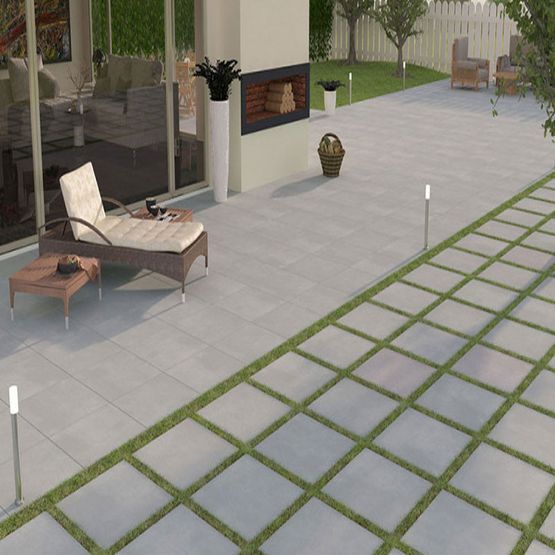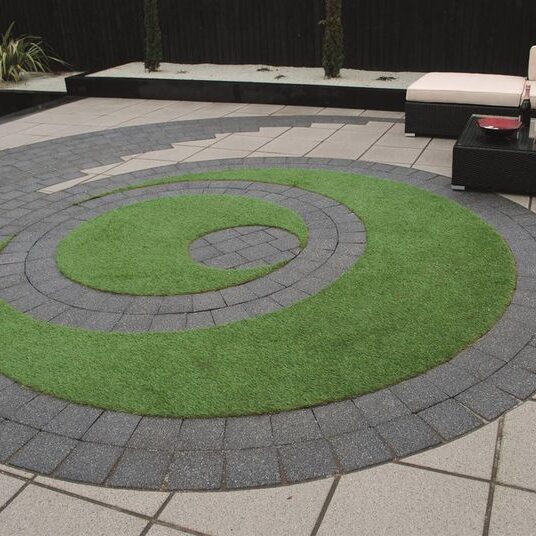Paving slabs are crucial components for your pathways, patios, and outdoor spaces. They come in an array of materials and sizes, not only adding charm to your garden but also packing a practical punch, whether used for dining areas or outdoor furnishings.
But when you’re planning your application, you might be asking yourself: how many slabs do I need?
The answer to that question heavily depends on your paving area and the size of your slabs. If you’re not sure how to work out the area of your space or calculate the slabs you require, don’t worry. This guide is here to show you how.
Table of Contents
- How do you calculate paving area?
- Calculating the area for an L-shaped lawn
- Calculating the area for a circular lawn
- Calculating the area for a triangular lawn
- How many paving slabs do I need?
- Paving slab sizes
- Final thoughts
How do you calculate paving area?
The best place to start when measuring for paving slabs is to find the area of your space or lawn. This will help you later work out how many paving slabs you need.

Calculating the area of a square or rectangular space or lawn is relatively easy, even without a paving calculator or slab calculator. All you need to do is measure the width and length of the space and multiply the two numbers together. For example, if your width is 10m and your length is 15m, your equation will be 10m x 15m = 150m². Honestly, it’s pretty foolproof.
If your designated space is an odd shape, however, it might be easier to divide it into regular shapes that are easier to calculate. These include triangles, squares, rectangles, or circles. Find the area of each shape and then add them together for the total area. You might want to sketch it out using paper and a pencil to make it easier, but don’t worry. We’ll go into this process in more detail.
Calculating the area for an L-shaped lawn
An L-shaped lawn might seem a bit tricky initially, but there’s an easy solution to working out the area. As we discussed before, you can split more obscure shapes into more regular ones. This means you can divide your L-shaped lawn into two rectangles and work out the areas of each.
Like before, measure the width and length, then multiply them to get the area. When you have the areas of both rectangles, you can add them together for the complete area of your lawn using the calculation (width x length) + (width x length). If the area of one rectangle is 12m² and the other is 20m², for example, you’ll want to calculate 12² + 20m² = 32m².
Easy enough, right?
Calculating the area for a circular lawn
Finding the area of a circular lawn is one of the more difficult calculations, but once you put it into practice, you’ll be grand.

You’ll first need to find the radius of the circle. You can do this by measuring the distance across the middle of the circle and then halving it. Once you have the radius, it’s time to square the number (which, in simpler terms, means to times it by itself) and then multiply it by Pi (3.14). The final value is the area you’re looking for. The complete calculation is area = 3.14 x radius².
For example, if your lawn diameter measures 20m, half it for the radius (10m). Next, multiply 10m x 10m = 100m and multiply that by 3.14. This would give you 100m x 3.14 = 314m².
Calculating the area for a triangular lawn
When it comes to triangular lawns, you should start by measuring the longest side of the triangle for the base and then measure vertically to the highest point for the height. Multiply these two values together and then divide the total by two to find your area (area = 0.5 x base x height).
If the base of your triangle is 5m and the height is 9m, you would calculate 5m x 9m = 45m and then divide that by two. This gives you an area of 22.5m².
Even if your lawn isn’t triangular, this method is particularly helpful when you need to split up your lawn into different shapes.
How many paving slabs do I need?
Now that you’ve found the area of your lawn or where you’ll be laying slabs, it’s time to figure out how many paving slabs you’ll need. This will depend on the paving slab you choose and the dimensions of it.

For this calculation, you’ll also need to work out the area of your paving slab. Once again, find the width and length and multiply them. Take the total area of your space and divide it by the total area of your paving slab. The number you end up with will be the number of paving slabs you require. Always remember to account for an extra 10% when working out how many slabs you need as this will accommodate any breakages during delivery and installation.
We recommend finding the correct quantity when ordering your slabs, it’ll prevent you from overspending on paving slabs you don’t need. Likewise, it’ll make sure you’ve bought enough (the extra 10% included) – this will save you time and money during installation that might otherwise be wasted on ordering more paving slabs.
Paving slab sizes
When exploring the variety of paving slabs on offer, you’ll notice a whole range of sizes and dimensions for you to choose from. Typically, 300mm x 300mm and 600mm x 600mm paving slabs are popular options, especially for DIYers wanting to create patios and pathways, though it will depend on the space you have and the look you want to achieve.
Large slabs can be effective when filling large spaces, when achieving a modern appearance, or when trying to create the look of more space than is actually on offer. However, it’s worth recognising that large slabs in small places can bring some difficulties when it comes to installation if they don’t fit seamlessly. You can trim your large slabs with a chisel and hammer or a circular saw, but this can be time-consuming.
If you’re looking for a more intricate amount of detail, you might want to use smaller paving slabs. These will also be easier to handle during installation, but there can be a lot of them depending on your space, so you should weigh up the pros and cons before your purchase. Pavers are also a fantastic option – unlike paving slabs, these are small and thick.
Sometimes square slabs aren’t the design you’re looking for. In this case, why not try a different shape and dimension? 900mm x 600mm slabs have recently risen in popularity and are ideal for when you want an elongated appearance. They also cover more space, meaning fewer slabs are required.
Final Thoughts
Now we’ve gone through the process of measuring for laying paving slabs and the benefits of different sizes, it’s time for you to grab a tape measure, channel your inner DIY champ, and let the paving projects begin! As soon as you’ve worked out your paving area and calculated how many slabs you need, you’ll be good to get started.
And then, before you even know it, you’ll be kicking back on your paving slabs and raising a glass to your measuring skills. Here’s to smooth sailing and even smoother paving!











